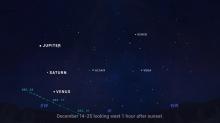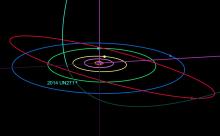Listen to today's episode of StarDate on the web the same day it airs in high-quality streaming audio without any extra ads or announcements. Choose a $8 one-month pass, or listen every day for a year for just $30.
You are here
Orionid Meteors
Halley’s Comet won’t return to the inner solar system for another four decades. But it makes its presence known tonight with a meteor shower. The shower isn’t named for the comet, though. Instead, it’s named for the region of sky in which its meteors appear to “rain” into the atmosphere — the constellation Orion.
A meteor shower takes place when Earth flies through the orbital path of a comet, which is a big ball of frozen water and gases mixed with bits of rock and dirt. As the comet gets close to the Sun, some of the ices vaporize, releasing some of the solid particles. Over time, these bits of dust spread out along the comet’s path.
Halley has made many trips around the Sun, so it’s shed a lot of debris. The comet dust has spread out all along its orbit. Earth flies through this path every October. As the particles hit the atmosphere they vaporize, forming the incandescent streaks known as meteors.
The Orionids are pretty reliable, although not usually spectacular. At their peak, they produce a couple of dozen meteors per hour.
This year’s shower will be at its best tonight, although a few Orionids punctuate the sky for several nights after the peak. The Moon is a crescent in the early evening sky tonight, so it sets well before the shower starts to speckle the night — providing dark skies for the “calling cards” of Halley’s Comet.
Tomorrow: the Moon and some bright companions in the evening sky.
Script by Damond Benningfield






